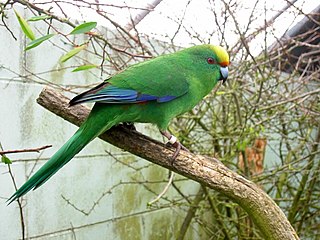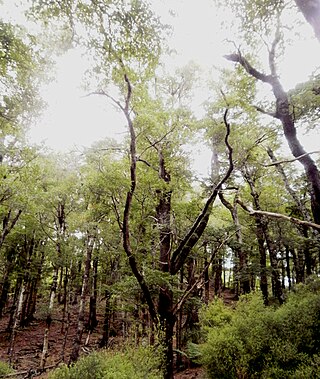
Fagus grandifolia, the American beech or North American beech, is the only species of beech native to North America. Its current range comprises the eastern United States, isolated pockets of Mexico and southeastern Canada. Prior to the glacial maximum of the Pleistocene epoch, the tree flourished over most of North America, reaching California.

The Zanzibar red colobus is a species of red colobus monkey endemic to Unguja, the main island of the Zanzibar Archipelago, off the coast of Tanzania. It is also known as Kirk's red colobus after Sir John Kirk, the British Resident of Zanzibar who first brought it to the attention of zoological science. It is now classified as an endangered species and in the mid-1990s was adopted as the flagship species for conservation in Zanzibar. The population is still decreasing, and conservationists are attempting to work with the local government to devise a proper, effective strategy to protect the population and habitat. Challenges include the species' habitat, which is limited to the archipelago. The species has been reclassified three times; it was previously in the genus Colobus, then in the genus Procolobus, and later in the genus Piliocolobus.

Malherbe's parakeet is a small parrot endemic to New Zealand, where it is known as the orange-fronted parakeet or orange-fronted kākāriki. In the rest of the world it is called Malherbe's parakeet, as when it was recognised as a species, the name "orange-fronted parakeet" was already used for Eupsittula canicularis, a Central American species. Restricted to a few valleys in the South Island and four offshore islands, its population declined to around 200 in the 1990s, and it is considered critically endangered by the IUCN.

Juglans cinerea, commonly known as butternut or white walnut, is a species of walnut native to the eastern United States and southeast Canada.

The red-rumped woodpecker is a species of bird in the subfamily Picinae of the woodpecker family Picidae. It is found from Costa Rica south to Peru and east to Brazil, Guyana, and Trinidad and Tobago.

Nothofagus cunninghamii, commonly known as myrtle beech or Tasmanian myrtle, is the dominant species of cool temperate rainforests in Tasmania and Southern Victoria. It has low fire resistance and grows best in partial shade conditions.

Nothofagus gunnii, the tanglefoot or deciduous beech, is a deciduous shrub or small tree endemic to the highlands of Tasmania, Australia. It was described in 1847 by R.C Gunn N. gunnii is a small woody tree with a shrubby appearance known to grow up to 8 metres (26 ft). It lives only on mountains due to temperature limitations within the Tasmanian maritime climate and mainly grows at altitudes greater than 800 metres (2,600 ft) above sea level. It grows in alpine and sub-alpine regions in the central portions of the island. Though capable of reaching the size of a small tree, it is most common as a thick shrub or woody ground cover, hence its common name of "tanglefoot".

Halocarpus kirkii, or monoao, is a species of conifer in the family Podocarpaceae. It is native and endemic to New Zealand. It was formerly known as Dacrydium kirkii.

Nothofagus fusca, commonly known as red beech is a species of southern beech, endemic to New Zealand, occurring on both the North and South Island. It is generally found on lower hills and inland valley floors where soil is fertile and well drained. In New Zealand the species is called Fuscospora fusca.

Nothofagus menziesii, commonly known as silver beech, is a tree of the southern beech family endemic to New Zealand. Its common name probably comes from the fact that its bark is whitish in colour, particularly in younger specimens. It is found from Thames southwards in the North Island, and throughout the South Island. Silver beech is a forest tree up to 30 m tall. The trunk, which is often buttressed, may be up to 2 m in diameter. The leaves are small, thick and almost round in shape, 6 to 15 mm long and 5 to 15 mm wide with rounded teeth which usually occur in pairs, 1 or 2 hair fringed domatia are found on the underside of each leaf. Its Māori name is tawhai. It grows from low altitudes to the mountains. Nothofagus menziesii was proposed to be renamed Lophozonia menziesii in 2013.

Nothofagus truncata, or hard beech, is a species of tree endemic to New Zealand. Its common name derives from the fact that the timber has a high silica content, making it tough and difficult to saw. Hard beech is a tree up to 30m tall occurring in lowland and lower montane forest from latitude 35°S to 42°30'S, that is, from the north of the North Island southwards to Marlborough and south Westland in the South Island. In Taranaki it forms almost pure stands on the rugged sandstone country there and is partially deciduous, dropping many of its leaves at the end of the winter. N. truncata became known as Fuscospora truncata after 2013 in New Zealand.

Nothofagus solandri, commonly called black beech, is species of tree endemic to New Zealand. Black beech occurs on both the North and the South Island at low elevations up to the mountains. It is also known as Nothofagus solandri var.solandri. In New Zealand the taxon is often called Fuscospora solandri.

Nothofagus alessandrii, the ruil, is a species of plant in the family Nothofagaceae, commonly known as the southern beeches. It is endemic to Chile, occurring chiefly in the Chilean matorral ecoregion. It is threatened by habitat loss. The species is protected within Los Ruiles National Reserve.

The North Island robin is a species of Australasian robin endemic to the North Island of New Zealand. It and the South Island robin of the South Island and Stewart Island were once considered conspecific, but mitochondrial DNA sequences have shown that the two lineages split prior to the Pleistocene, and support the classification as two different species.

The Kirk's blenny is a species of combtooth blenny in the genus Alticus. It was described by A. Günther in 1964, originally as a member of the genus Salarias. It is a tropical blenny which is known from the Red Sea, Mozambique, Réunion, the Persian Gulf, and India, in the Indian Ocean. Kirk's blennies inhabit waters near the shore, and often spend time out of the water. They are able to breathe air when on land. They are oviparous, and form distinct pairs when mating; they also guard their eggs.

Nothofagus cliffortioides, commonly called mountain beech, is a species of Southern beech tree and is endemic to New Zealand. Mountain beech grows in mountainous regions at high elevations. In New Zealand the taxon is called Fuscospora cliffortioides. Nothofagus cliffortioides occupies a wider range of habitat than any other New Zealand tree species and it shows a corresponding range of life form, seeding habits, regenerative patterns, growth habits, growth rates, stand replacement and mortality patterns.

Boletopsis nothofagi is a fungus in the family Bankeraceae. The fungus forms grey fruit bodies that grow in clusters. Like all species of Boletopsis, it has a porous spore-bearing surface on the underside of the cap, but differs from other species of Boletopsis by having characteristics such as elongated spores and a green discoloration when stained with potassium hydroxide. Boletopsis nothofagi is endemic to New Zealand and has a mycorrhizal association with red beech. It is unknown when exactly the fungus forms its fruit body, but it has so far been found solely in May, during autumn in the Southern Hemisphere.

Bondarzewia berkeleyi, commonly known as Berkeley's polypore, or stump blossoms, is a species of polypore fungus in the family Russulaceae. It is a parasitic species that causes butt rot in oaks and other hardwood trees. A widespread fungus, it is found in Africa, Asia, Europe, and North America.

Tyromyces pulcherrimus, commonly known as the strawberry bracket, is a species of poroid fungus in the family Polyporaceae. It is readily recognisable by its reddish fruit bodies with pores on the cap underside. The fungus is found natively in Australia and New Zealand, where it causes a white rot in living and dead logs of southern beech and eucalyptus. In southern Brazil, it is an introduced species that is associated with imported eucalypts.



















